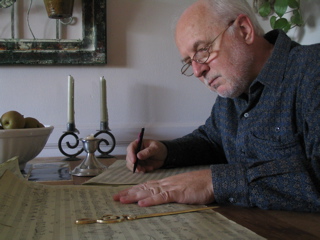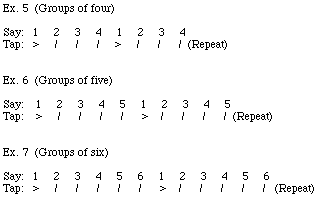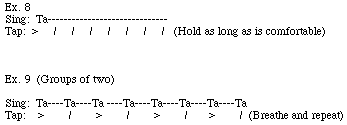[Woodwinds/Piano] [Guitar Music] [Easy Piano Music] [Whitco Press]
[How To Read Music] [Copyright]
[Selected Works]

How To Read Music
by Richard White
For those wishing to comment on anything here or who want to see other portions of the text, a short note will be most welcome. A full edition of HOW TO READ MUSIC is now in production. This material is copyrighted © 1992 by Whitco Press. All Rights Reserved.
PART ONE
Section One - Time (The Beat and Rhythm)
1. As mentioned in the Preface, experience has shown that "faulty rhythm" is the number one problem among performing musicians on all but the highest levels. For this reason this book will begin with -- and detail -- a method of learning to interpret rhythms from the printed page accurately and with confidence, thereby eliminating this problem altogether.
You will find the explanations of rhythm to be simple, practical, and effective. They will afford you a clear understanding of what rhythm is, most especially how it relates to time. Since the method outlined in Part One is as straightforward as the system of musical notation itself, I'm certain with a little practice and patience you will find learning it simple.
As with any endeavor, we all have different aptitudes for things. Some are naturally inclined, while others seem to struggle. Rhythmically, wherever you may find yourself in this continuum, rest assured that not only can anyone eventually develop a good sense of rhythm, they can also learn to do so while relating to the printed page. However much effort is necessary for you to put into the exercises in this book will eventually prove well worth the effort because, without that effort, good music-making is virtually impossible to achieve.
Our present-day system of musical notation is a highly efficient and accurate method of notating and preserving musical sounds on paper, having evolved over centuries of trial and error. Rhythmically, it offers an extremely accurate and dependable method of `notating the division of time into varying lengths, enough to satisfy virtually any rhythm imaginable.
2. The most important and obvious principle to grasp is this: In order to unravel and reveal its great beauties, music must have time in which to do so. In other words, music takes place in time. Moreover, it must have a way to do so in an orderly fashion, wherein one can handle several layers of time simultaneously. (More on this later.) This is what is meant when it is said a particular musician has a "good sense of timing" or a "good sense of rhythm."
Try this little experiment: Sit quietly and close your eyes. Listen to the sounds around you for a few moments. Have you noticed that the sounds you hear (i.e. - a ticking clock; a blaring car horn or siren; a chirping bird) not only took place in time, but that each sound had the effect of punctuating time by varying lengths? Perhaps two or more sounds occurred simultaneously? Maybe they overlapped? Were there any sounds which appeared to have a regular beat? Were any irregular in beat? Whatever your particular experience was, in all cases, each sound had a beginning and an end and, most likely, occurred in patterns. In music, these patterns are called rhythm. Essentially, if we consider the other aspects of the sounds you heard -- whether the sounds were high or low, loud or soft, sharply or smoothly articulated -- you just heard a piece of random music.
So there you have it: Sounds taking place in time and punctuating time into varying lengths and patterns. With a few modifications and refinements, this is also the definition of music itself. In other words, tones (notes or pitches which can be high or low, loud or soft, jagged or smooth) take place in time, and have different rhythms and patterns.
3. As mentioned previously, the written language of music includes a simple and orderly system of notation. While it is simple to comprehend and learn and utilizes only a handful of symbols, this system allows for an infinite variety of ways to notate highly complex rhythms. But before we get to the actual system itself, we'll start with a series of simple exercises designed to give you a practical, hands-on understanding of the relationship between time and rhythm by starting with the fundamental layer of time known as the beat or pulse. (These two terms are synonymous.) It is vitally important you become as comfortable as possible creating and maintaining a steady beat because it underlies and acts as a foundation for all music. It is always present and is what you feel when you are inspired to movement when listening to music or dancing to it.
How To Create A Beat (Pulse)
At a comfortably slow and even (steady) pace, use your hand to gently, but firmly, tap with the tips of your fingers on a flat surface thus: (The key words here are slow and even.)
Make absolutely certain your pace is even and steady at all times and that you are in full control, When done correctly, it should have the monotonous effect of a ticking clock. Practice this thoroughly before proceeding.
Next, let's articulate our beat with some accents. In the same manner as in the previous exercise, accent (make heavier) every other beat by tapping them noticeably louder. This will give us two distinct sounds, a primary (accented or strong) beat, and a secondary (weak) beat. For our purposes, these beats will be notated as follows: > (primary beat) and / (secondary beat).
When we eventually get to use actual musical notation, you will find that -- without exception -- all music has various combinations of both primary and secondary beats.
• Remember: Since this is your opportunity to build a solid and lasting rhythmic foundation, monitor your pace so it is always slow and steady. If for any reason you are having a difficult time keeping your pace steady or are not sure you are, it might be helpful to use a mechanical device such as a loud clicking clock for support. Most clocks of this kind tick at one second intervals, a speed which is comfortable enough to enable you to make it through these initial exercises quite easily. For more flexibility, however, use a metronome, which can vary speeds. To start out, set the metronome at 60, or one click per second. As you become more adept at handling these exercises, you may increase the metronome speed in small increments at a time.
Once you have mastered Ex. 2, try adding some counting, as in the following:
When done correctly, Ex. 3 should sound exactly like Ex. 2.
Now try accenting beats in different groupings. Repeat each exercise as many times as you needed in order to create a comfortable flow to your rhythms.
• Do not proceed until you feel comfortable with the previous exercises and you are certain your beat is always steady and even.
4. Now, using your singing voice, let's add some musical sounds to the beat. Take a deep breath and sing any note that is comfortable for you, using the syllable Ta as follows:
Now try adding different accents. Remember to hold each sound through until you sing the next sound and try not to breathe until indicated, Also be sure your accented beats are noticeably stronger and louder than the non-accented beats.
5. When you are comfortable enough to continue, try the following exercises. They comprise various combinations of the previous exercises.![]()










Rhythm
6. Until now we have been working only with the fundamental layer of time, the beat. To add more interest we will now add a second layer of time to the beat known as rhythm. The most distinguishing feature of rhythm is its irregularity. While the beat remains constant and unyielding, acting as the foundation which paces the music, the rhythm "dances" above the beat, creating more interesting, irregular, and active patterns. For example, it is entirely possible to identify a familiar song by hearing only its rhythmic pattern. (i.e. tapping the rhythm of London Bridge or Joy to the World without singing the melody.) Try this with these songs (or any other song familiar to you). Better yet, ask a friend to do this for you and try to identify the song hearing only its rhythmic pattern.
Now, while trying the following exercises, notice how the rhythm (the part you sing or play) does not occur on every beat. You may also notice how similar handling the two layers of time (beat and rhythm) is to juggling. It is all a matter of coordination between what you are singing or playing (rhythm), and what you are tapping (beat) while keeping an even beat. From these exercises it should become clear just how interrelated beat and rhythm are, and just how dependent one is upon the other. In fact, one cannot exist without the other. Remember to go slowly at first, always maintaining a steady beat so the rhythmic patterns can be distinctly heard. Incidentally, the faster these exercises are done, the more apparent the rhythmic patterns will be. Bide your time, however, and start slowly at first, increasing speed only in small increments.
7. The next rhythmic examples are the opening portions of three well-known tunes. Practice them slowly a few times until you get the hang of them, then speed them up a bit until you can identify each one. The answers are at the end of this section.
Final Note: At first glance, these preliminary rhythmic exercises may seem a bit simplistic. Therefore, there is always the danger of glossing over them. It is strongly recommended you do not do this or treat them lightly in any way! These exercises were especially designed to give you a clear understanding of the crucial interrelationship between beat and rhythm. There is, perhaps, no more important relationship than that between beat and rhythm, since all music uses these two core elements. They lie at the very foundation of music of all types and styles around the world. It is further recommended that you review this section until you are certain you not only understand its contents, but that you can do every exercise accurately and fluently. This will make it all the more easy when we add the actual symbols for rhythmic notation, not to mention the other elements such as notes (pitches), dynamics (louds and softs), and articulation.
If you have not already done so, you should go back over the exercises and check the accuracy of your beat using a metronome. They are not expensive, and can provide a lifetime of use whenever you are in doubt about your beat or rhythm. Be warned: There is no room for subjectivity when it comes to beat and rhythm. They are either right or they aren't. A faulty sense of beat or an uneven beat is the real source of all rhythmic problems. Finally, do not be discouraged if everything does not fall into place right away. More often than not it won't. With patience and practice through repetition anyone can master beat and rhythm.






Summary
1. The two fundamental divisions of time are beat (pulse) and rhythm.
2. The beat (pulse) is the fundamental element of music which divides time into equal portions that steadily paces a piece of music. There are two types of beats: primary (strong or accented) and secondary (weak) .
3. Rhythm is the irregular pattern (or patterns) which uses the beat as its foundation. Rhythm and beat must always work in conjunction with one another.
4. The beat must be even and slow enough so you can control the rhythms.
5. Use only the fingers of the hand (not the palm or the foot!) when tapping the beat. The voice or a piano should be used when doing the rhythms.
6. Be sure there is a clear distinction between accented (>) beats and unaccented (/) beats.
8. Always hold each "ta" through to the next "ta".
9. For rhythmic support, use a mechanical device such as a metronome to check the steadiness of the beat.
10. Never proceed to the next exercise until you have mastered the one you are working on.![]()
Answers To Ex. 20, 21, and 22: (Ex. 20) America; (Ex. 21) Rudolph, The Red-Nosed Reindeer; (Ex. 22) Drink To Me Only With Thine Eyes.
• Stop and Review!
This material is copyrighted © 1992 by Whitco Press. All Rights Reserved International Copyright Secured
[Woodwinds/Piano] [Guitar Music] [Easy Piano Music] [Whitco Press]
[How To Read Music] [Copyright]
[Selected Works]
This site and its entire contents © 2003 by Richard White (Whitco Press)